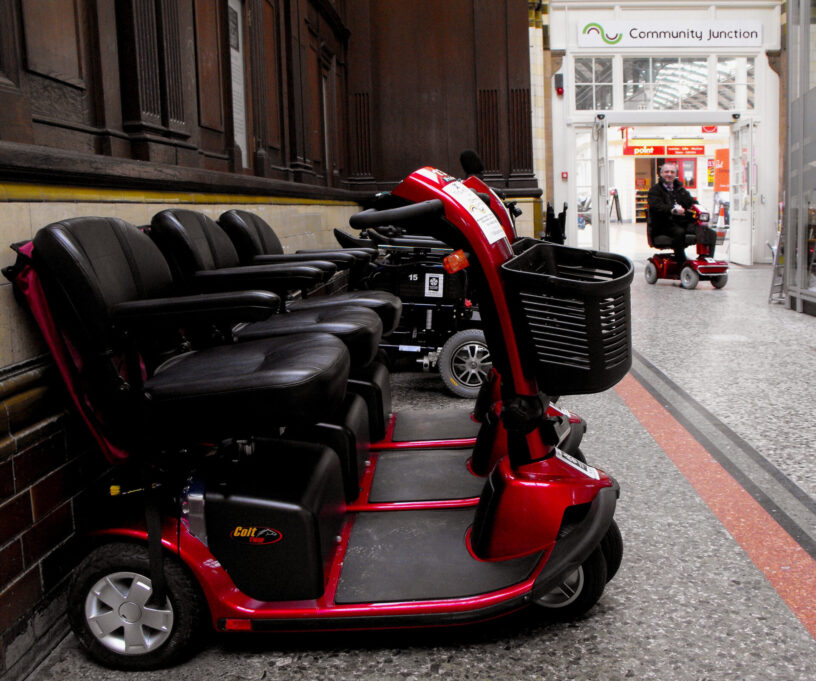Mobility Scooters Market was valued at $1.72 billion in 2020, and is projected to reach $3.21 billion by 2030, registering a CAGR of 6.5% from 2021 to 2030.
The mobility scooters market refers to the market for electric or motorized scooters designed for individuals with limited mobility, particularly the elderly and those with disabilities. These scooters help people move independently and comfortably, making them essential for improving the quality of life for individuals facing physical limitations. Mobility scooters are typically used outdoors but can also be used in large indoor spaces such as malls, airports, or hospitals.
The increasing aging population, rising rates of disabilities, advancements in mobility solutions, and the growing demand for personal independence are driving the demand for mobility scooters globally.
Market Segmentation
- By Product Type:
- Class 2 Scooters (Standard Mobility Scooters): Operate on pavements and have a maximum speed of up to 4 mph.
- Class 3 Scooters (Road Legal Scooters): Capable of driving on roads, these have higher speed limits (up to 8 mph) and are equipped with more advanced safety features.
- By Wheel Type:
- 3-Wheel Scooters: Offer greater maneuverability, making them ideal for use in smaller spaces.
- 4-Wheel Scooters: Provide better stability and are designed for use on uneven surfaces, making them suitable for outdoor use.
- By End-User:
- Elderly Population: The primary users of mobility scooters due to age-related physical limitations.
- Disabled Population: Individuals with physical disabilities who require mobility assistance.
- By Distribution Channel:
- Online Stores: A growing segment due to the convenience of ordering and home delivery.
- Retail Stores and Medical Supply Stores: A traditional purchasing method where consumers can test and try scooters before purchasing.
Market Trends
- Aging Global Population:
- The growing elderly population is the primary driver of the mobility scooters market. According to the World Health Organization (WHO), the proportion of the global population over the age of 60 is expected to nearly double by 2050. As mobility decreases with age, the demand for scooters is likely to increase.
- Technological Advancements:
- Recent innovations in mobility scooters include lightweight and foldable designs, longer battery life, Bluetooth connectivity, and GPS tracking. These advancements make scooters more user-friendly, accessible, and customizable, driving market demand.
- Increase in Personal Independence:
- People with limited mobility increasingly prefer products that enable independence and freedom of movement. Mobility scooters offer an ideal solution for daily activities, enhancing the lifestyle and self-reliance of users.
- Portable and Foldable Models:
- The demand for compact, foldable, and lightweight mobility scooters is rising as they offer greater convenience for travel and storage. These models are designed for easy transportation and are particularly popular among frequent travelers and those who live in smaller spaces.
- Growth of Online Sales:
- The rise of e-commerce platforms and online sales channels has expanded the market reach of mobility scooters. Consumers can now easily compare prices, read reviews, and order products online, which has contributed to increased accessibility and sales.
- Government Subsidies and Healthcare Policies:
- In many countries, governments and healthcare systems offer financial support for mobility aids, including scooters. This has made mobility scooters more affordable for a larger portion of the population.
Market Drivers
- Rising Incidence of Disabilities:
- The prevalence of physical disabilities due to aging, accidents, or chronic conditions is increasing globally, boosting the demand for mobility aids such as scooters. Conditions such as arthritis, stroke, Parkinson’s disease, and musculoskeletal disorders require mobility assistance.
- Technological Advancements and Innovation:
- Continuous technological advancements in battery life, ergonomics, and safety features are making mobility scooters more attractive to users. Innovations such as swappable batteries, enhanced suspension systems, and pneumatic tires for rough terrain are also increasing adoption.
- Urbanization and Infrastructure Development:
- As urban areas become more accessible to individuals with disabilities through improved infrastructure (e.g., ramps, wider sidewalks, and public transport accessibility), the usability of mobility scooters has increased. This trend supports market growth, especially in developed regions.
- Rising Healthcare Spending:
- Increased spending on healthcare and assistive technologies in developed and developing countries is expected to propel the market. Governments and private sectors are focusing more on senior care and rehabilitation, which will contribute to market growth.
- Increased Awareness of Mobility Solutions:
- Greater awareness of mobility solutions, through healthcare professionals, rehabilitation centers, and online platforms, is driving demand for mobility scooters. Educational campaigns and promotions have also led to higher adoption rates.
Challenges
- High Cost of Mobility Scooters:
- The cost of high-quality, advanced mobility scooters remains a significant barrier for many potential users, especially in low-income regions. Though some government programs offer subsidies, the high upfront cost of scooters can limit market growth.
- Limited Accessibility in Developing Regions:
- In many developing regions, the lack of adequate infrastructure (e.g., accessible streets, ramps, and public transportation) limits the use of mobility scooters. Moreover, limited awareness and affordability in these regions hinder market expansion.
- Battery Limitations:
- While advancements in battery technology are improving, some mobility scooters still have limitations in terms of battery life and charging time. This can restrict their use for longer distances, particularly for users who rely on their scooter throughout the day.
- Stigma and Reluctance:
- Some potential users may hesitate to use mobility scooters due to stigma associated with visible physical aids, or they may prefer less noticeable forms of assistance. Overcoming social stigma and encouraging independence through the use of these devices is an ongoing challenge.
- Product Maintenance and Repair:
- Mobility scooters require regular maintenance and repairs, which can be expensive and inconvenient for users. Lack of access to repair services, particularly in rural areas, is another issue that may hinder the adoption of these devices.
Future Outlook
- Innovations in Battery Technology:
- The development of longer-lasting batteries and faster charging solutions is expected to significantly improve the usability of mobility scooters. Lithium-ion batteries, in particular, are being increasingly adopted for their longer lifespan and efficiency.
- Integration of Smart Technology:
- The incorporation of smart technologies like GPS, remote tracking, fall detection, and health monitoring systems into mobility scooters is likely to revolutionize the market. These features can improve safety and convenience, particularly for elderly users.
- Growth in Emerging Markets:
- Emerging markets, especially in Asia-Pacific and Latin America, present significant growth opportunities. Rising disposable income, increased healthcare access, and improving awareness about mobility aids will drive demand in these regions.
- Sustainability Trends:
- There is an increasing focus on developing eco-friendly scooters with recyclable materials and energy-efficient motors. This shift aligns with growing consumer awareness of environmental issues and the demand for sustainable products.
- Collaborations with Healthcare Providers:
- Partnerships between mobility scooter manufacturers and healthcare providers, rehabilitation centers, and senior care facilities will enhance product distribution and awareness. Healthcare professionals play a key role in recommending mobility solutions to patients.
Conclusion
The Mobility Scooters Market is set for steady growth, driven by an aging population, increased prevalence of disabilities, and continuous technological advancements. Innovations in battery life, portability, and smart integration will further enhance the user experience, while expanding accessibility through online channels and government support will contribute to broader market penetration. Challenges such as high costs and maintenance requirements remain, but the market’s future looks promising with significant growth potential in both developed and emerging regions.
Click Here, To Get Free Sample Report https://stringentdatalytics.com/sample-request/mobility-scooters-market/15588/
Market Segmentations:
Global Mobility Scooters Market: By Company
Quingo
Invacare
Drive medical
Pride Mobility Products
Electric Mobility
Afikim Electric Vehicles
Amigo Mobility International
Golden Technologies
Hoveround
KYMCO
Merits Health
Sunrise Medical
TGA Mobility
Global Mobility Scooters Market: By Type
Pavement Scooters
Road Scooters
Global Mobility Scooters Market: By Application
Residential
Commercial
Global Mobility Scooters Market: Regional Analysis
The regional analysis of the global Mobility Scooters market provides insights into the market’s performance across different regions of the world. The analysis is based on recent and future trends and includes market forecast for the prediction period. The countries covered in the regional analysis of the Mobility Scooters market report are as follows:
North America: The North America region includes the U.S., Canada, and Mexico. The U.S. is the largest market for Cold-chain Pharma in this region, followed by Canada and Mexico. The market growth in this region is primarily driven by the presence of key market players and the increasing demand for the product.
Europe: The Europe region includes Germany, France, U.K., Russia, Italy, Spain, Turkey, Netherlands, Switzerland, Belgium, and Rest of Europe. Germany is the largest market for Cold-chain Pharma in this region, followed by the U.K. and France. The market growth in this region is driven by the increasing demand for the product in the automotive and aerospace sectors.
Asia-Pacific: The Asia-Pacific region includes Singapore, Malaysia, Australia, Thailand, Indonesia, Philippines, China, Japan, India, South Korea, and Rest of Asia-Pacific. China is the largest market for Cold-chain Pharma in this region, followed by Japan and India. The market growth in this region is driven by the increasing adoption of the product in various end-use industries, such as automotive, aerospace, and construction.
Middle East and Africa: The Middle East and Africa region includes Saudi Arabia, U.A.E, South Africa, Egypt, Israel, and Rest of Middle East and Africa. The market growth in this region is driven by the increasing demand for the product in the aerospace and defense sectors.
South America: The South America region includes Argentina, Brazil, and Rest of South America. Brazil is the largest market for Cold-chain Pharma in this region, followed by Argentina. The market growth in this region is primarily driven by the increasing demand for the product in the automotive sector.
Click Here, To Buy Premium Report https://stringentdatalytics.com/purchase/mobility-scooters-market/15588/?license=single
About Stringent Datalytics
Stringent Datalytics offers both custom and syndicated market research reports. Custom market research reports are tailored to a specific client’s needs and requirements. These reports provide unique insights into a particular industry or market segment and can help businesses make informed decisions about their strategies and operations.
Syndicated market research reports, on the other hand, are pre-existing reports that are available for purchase by multiple clients. These reports are often produced on a regular basis, such as annually or quarterly, and cover a broad range of industries and market segments. Syndicated reports provide clients with insights into industry trends, market sizes, and competitive landscapes. By offering both custom and syndicated reports, Stringent Datalytics can provide clients with a range of market research solutions that can be customized to their specific needs.
Contact Us
Stringent Datalytics
Contact No- +1 346 666 6655
Email Id- sales@stringentdatalytics.com




Leave a Reply